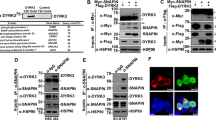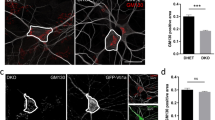Abstract
The mammalian Class III phosphoinositide 3-kinase (PIK3C3, also known as mammalian vacuolar protein sorting 34 homologue, Vps34) is a regulator of vesicular trafficking, autophagy, and nutrient sensing. In this study, we generated a specific antibody against PIK3C3, and carried out expression and morphological analyses of PIK3C3 during mouse brain development. In Western blotting, PIK3C3 was detected throughout the developmental process with higher expression in the early embryonic stage. In immunohistochemical analyses with embryonic day 16 mouse brain, PIK3C3 was detected strongly in the axon of cortical neurons. While PIK3C3 was distributed at the soma, nucleus, axon, and dendrites in primary cultured mouse hippocampal neurons at 3 days in vitro (div), it was also found in a punctate distribution with partial colocalization with synaptic marker, synaptophysin, at 21 div. The obtained results indicate that PIK3C3 is expressed and may have a physiological role in central nervous system during corticogenesis.



Similar content being viewed by others
References
Fruman DA, Meyers RE, Cantley LC (1998) Phosphoinositide kinases. Annu Rev Biochem 67:481–507
Vanhaesebroeck B, Leevers SJ, Ahmadi K, Timms J, Katso R, Driscoll PC, Woscholski R, Parker PJ, Waterfield MD (2001) Synthesis and function of 3-phosphorylated inositol lipids. Annu Rev Biochem 70:535–602
Backer JM (2008) The regulation and function of Class III PI3Ks: novel roles for Vps34. Biochem J 410:1–17
Herman PK, Emr SD (1990) Characterization of VPS34, a gene required for vacuolar protein sorting and vacuole segregation in Saccharomyces cerevisiae. Mol Cell Biol 10:6742–6754
Schu PV, Takegawa K, Fry MJ, Stack JH, Waterfield MD, Emr SD (1993) Phosphatidylinositol 3-kinase encoded by yeast VPS 34 gene essential for protein sorting. Science 260:88–91
Siddhanta U, McIlroy J, Shah A, Zhang Y, Backer JM (1998) Distinct roles for the p110alpha and hVPS34 phosphatidylinositol 3′-kinases in vesicular trafficking, regulation of the actin cytoskeleton, and mitogenesis. J Cell Biol 143:1647–1659
Christoforidis S, McBride HM, Burgoyne RD, Zerial M (1999) The Rab5 effector EEA1 is a core component of endosome docking. Nature 397:621–625
Nielsen E, Severin F, Backer JM, Hyman AA, Zerial M (1999) Rab5 regulates motility of early endosomes on microtubules. Nat Cell Biol 1:376–382
Futter CE, Collinson LM, Backer JM, Hopkins CR (2001) Human VPS34 is required for internal vesicle formation within multivesicular endosomes. J Cell Biol 155:1251–1264
Fratti RA, Backer JM, Gruenberg J, Corvera S, Deretic V (2001) Role of phosphatidylinositol 3-kinase and Rab5 effectors in phagosomal biogenesis and mycobacterial phagosome maturation arrest. J Cell Biol 154:631–644
Vieira OV, Botelho RJ, Rameh L, Brachmann SM, Matsuo T, Davidson HW, Schreiber A, Backer JM, Cantley LC, Grinstein S (2001) Distinct roles of class I and class III phosphatidylinositol 3-kinases in phagosome formation and maturation. J Cell Biol 155:19–25
Windmiller DA, Backer JM (2003) Distinct phosphoinositide 3-kinases mediate mast cell degranulation in response to G-protein-coupled versus FcεRI receptors. J Biol Chem 278:11874–11878
Waite K, Eickholt BJ (2010) The neurodevelopmental implications of PI3K signaling. Curr Top Microbiol Immunol 346:245–265
Zhou X, Takatoh J, Wang F (2011) The mammalian class 3 PI3K (PIK3C3) is required for early embryogenesis and cell proliferation. PLoS ONE 6:e16358
Wang L, Budolfson K, Wang F (2011) Pik3c3 deletion in pyramidal neurons results in loss of synapses, extensive gliosis and progressive neurodegeneration. Neuroscience 172:427–442
Hanai N, Nagata K, Kawajiri A, Shiromizu T, Saitoh N, Hasegawa Y, Murakami S, Inagaki M (2004) Biochemical and cell biological characterization of a mammalian septin, Sept11. FEBS Lett 568:83–88
Sudo K, Ito H, Iwamoto I, Morishita R, Asano T, Nagata K (2006) Identification of a cell polarity-related protein, Lin-7B, as a binding partner for a Rho effector, Rhotekin, and their possible interaction in neurons. Neurosci Res 56:347–355
Nagata K, Ito H, Iwamoto I, Morishita R, Asano T (2009) Interaction of a multi-domain adaptor protein, vinexin, with a Rho-effector, Rhotekin. Med Mol Morphol 42:9–15
Ito H, Morishita R, Shinoda T, Iwamoto I, Sudo K, Okamoto K, Nagata K (2010) Dysbindin-1, WAVE2 and Abi-1 form a complex that regulates dendritic spine formation. Mol Psychiatry 15:976–986
Murase K, Ito H, Kanoh H, Sudo K, Iwamoto I, Morishita R, Soubeyran P, Seishima M, Nagata K (2012) Cell biological characterization of a multi-domain adaptor protein, ArgBP2, in epithelial NMuMG cells, and identification of a novel short isoform. Med Mol Morphol 45:22–28
Inaguma Y, Ito H, Hara A, Iwamoto I, Matsumoto A, Yamagata T, Tabata H, Nagata K (2015) Morphological characterization of mammalian Timeless in the mouse brain development. Neurosci Res 92:21–28
Wolfer DP, Henehan-Beatty A, Stoeckli ET, Sonderegger P, Lipp HP (1994) Distribution of TAG-1/axonin-1 in fibre tracts and migratory streams of the developing mouse nervous system. J Comp Neurol 345:1–32
Wurmser AE, Gary JD, Emr SD (1999) Phosphoinositide 3-kinases and their FYVE domain-containing effectors as regulators of vacuolar/lysosomal membrane trafficking pathways. J Biol Chem 274:9129–9132
Lee KM, Hwang SK, Lee JA (2013) Neuronal Autophagy and neurodevelopmental disorders. Exp Neurobiol 22:133–142
Liang XH, Yu J, Brown K, Levine B (2001) Beclin 1 contains a leucine-rich nuclear export signal that is required for its autophagy and tumor suppressor function. Cancer Res 61:3443–3449
Acknowledgments
This work was supported in part by grants from Ministry of Education, Science, Technology, Sports, and Culture of Japan, a grant-in-aid of Health Labor Sciences Research Grants from the Ministry of Health, Labor, and Welfare, Japan, a grant-in-aid of the 24th General Assembly of the Japanese Association of Medical Science and Takeda Science Foundation.
Author information
Authors and Affiliations
Corresponding author
Rights and permissions
About this article
Cite this article
Inaguma, Y., Ito, H., Iwamoto, I. et al. Morphological characterization of Class III phosphoinositide 3-kinase during mouse brain development. Med Mol Morphol 49, 28–33 (2016). https://doi.org/10.1007/s00795-015-0116-1
Received:
Accepted:
Published:
Issue Date:
DOI: https://doi.org/10.1007/s00795-015-0116-1




